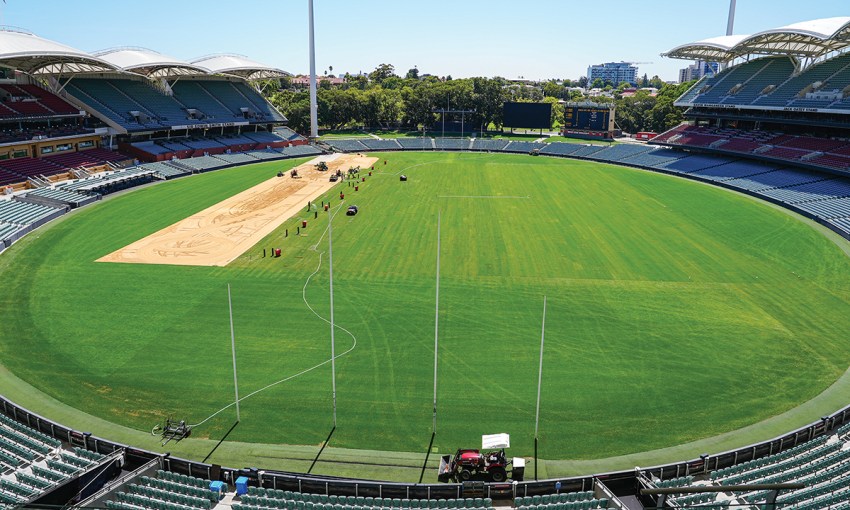Adelaide Oval’s grass: that divine oval-shaped patch of green carpet that has witnessed myriad triumphs and heartaches over its lifetime. It could also well lay claim to be the best lawn you’ll find anywhere in South Australia. Kim Syrus headed out to uncover the secrets to its success.
Our hallowed turf
For more than 150 years Adelaide Oval has laid claim to being South Australia’s most iconic sports venue.
Heralded as one of the most picturesque cricket grounds in the world, its hallowed turf has welcomed some of sport’s greatest players across a range of codes and witnessed so many memorable moments.
The great W.G. Grace captained an All-England XI against South Australia there in 1874 and then three years later football arrived with an intercolonial club match between Adelaide and St Kilda. The Adelaide Test in 1933 saw a combined crowd of 174,351 watch Jardine’s England beat Woodfull’s Australia – featuring the great Don Bradman – using the controversial “Bodyline” bowling tactics. Thankfully the first women’s Test match here against England in 1949 resulted in an Aussie victory, while English soccer whiz Sir Stanley Matthews enthralled spectators in Blackpool’s narrow 1-0 win over Australia in 1958.
More recently, Big Bash cricket, NRL, international soccer plus the Crows’ and Power’s men’s and women’s teams continue to draw a legion of fans, adding more memorable chapters to the stadium’s history.
Pivotal to the success of every sporting event at Adelaide Oval – albeit very much a quiet achiever – is the playing surface.
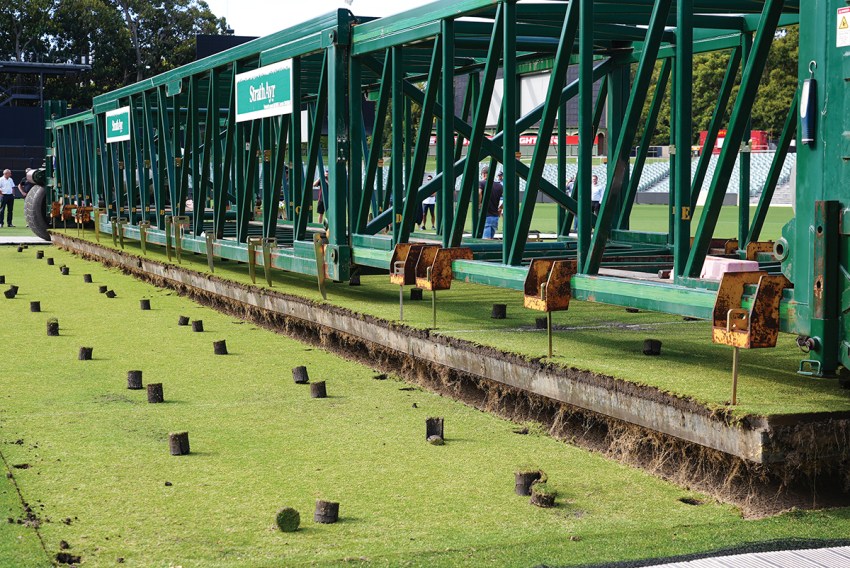
While the oval’s original dimensions of 190 metres by 125 metres have been reshaped to 167 metres by 124 metres, one element remains the same: a commitment from the groundskeeping team to providing the best turf possible.
And the key to that success is Damian Hough. A dedicated turf man, he took over the role of head curator from the highly knowledgeable Les Burdett back in July, 2010. What originally began as a six-month internship some 26 years ago, has seen Damian rise to the pinnacle of turf professionals in this state and across Australia, continuing the legacy of the head curators before him.
Hough’s love of turf is also shared by his dedicated team of 10 (11 during the summer months) as they carefully curate and maintain Adelaide Oval and its surrounds including the No. 2 Oval to the west of the stadium, the northern parklands, along the east and south entrances, and more recently, Next Generation’s 13 lawn tennis courts nearby.
A good portion of each day focuses on the oval’s main arena, the aim being to create the best quality and safest playing surface possible. Since this patch of grass not only hosts an extended summer of cricket, but a packed football program, along with a smattering of blockbuster concerts, the team faces a series of challenges, including turf variety.
Adelaide Oval’s playing surface is planted in rye grass, a clumping, fine-textured variety that grows into a thick and durable green carpet. Traditionally a cool-season type, a challenge for the groundskeepers is ensuring the rye grass looks good over summer, requiring careful and technical management.
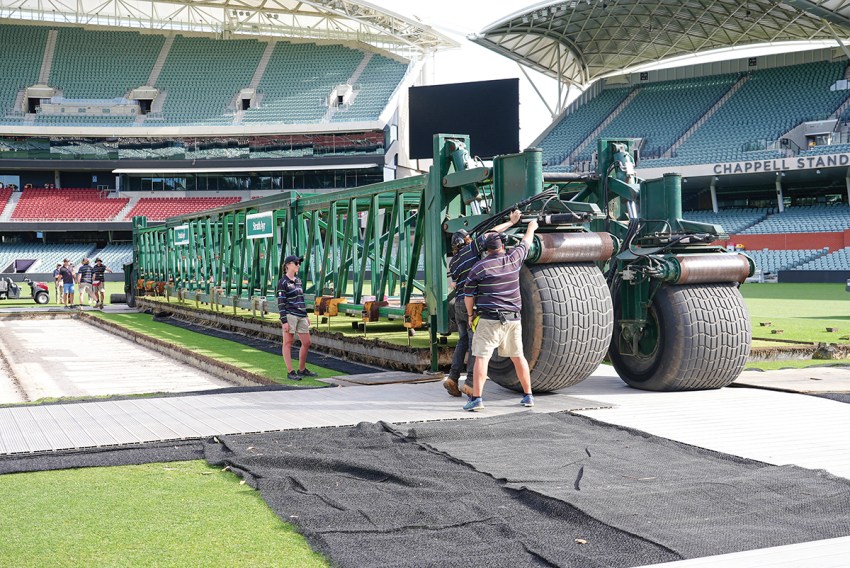
During the cricket season, lawn blade length is critical, too shaggy and that cracking cover drive will find it difficult to make the boundary. But while “dropping the mower blades a touch and cutting the turf shorter” may sound the simple solution, it’s not so, because rye grass prefers an unfriendly cricket length of 25mm. So, specially developed programs, incorporating twice-weekly (or more) mowing that shaves just the tiniest amount of grass each pass, coupled with a carefully monitored feeding regime have helped maintain a lower 10mm lawn height without compromising grass health. Quite an achievement.
Footy season might provide cooler and more suitable growing conditions for rye grass, but add in weekly games where players are running, falling, bouncing and bumping all over the surface and there’s yet another challenge to tackle.
Managing turf stress and creating a safe playing surface over the AFL, AFLW and SANFL seasons is Damian and his team’s top priority ensuring the best outcome on game day.
Preparation for each match begins the day after the last game. Divots are replaced, lumps levelled, and a light mow starts the week.
In an effort to better understand the turf’s health status, a soil test along with rye grass tissue samples are taken to determine what restorative action is required in the form of nutrient additives or microbial supplements to help maintain active and robust turf growth. Damian is a firm believer in using organic options where possible. There is so much science to the art of growing turf.
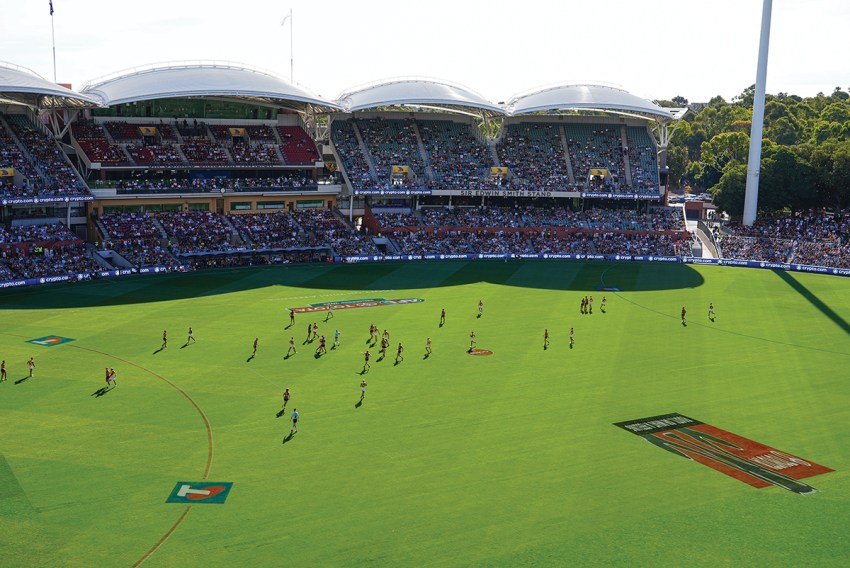
The next day comes aeration, because grass, as with all plants, needs air spaces around its roots to successfully grow. The rigors of an AFL game can compact the ground leaving the turf stressed, so using an aerator – where grids of small holes are punched across the oval – helps to open the soil and allow air to reach the roots, which encourages new root development, improves drainage and helps reduce compaction.
Having a playing surface that feels “softer” is very much appreciated by players and is an important safety consideration. The Adelaide Oval’s level of hardness is regularly tested using a Clegg Impact Tester, an instrument that measures the density of the playing surface to determine if additional aeration is needed, especially close to goals and through the centre square.
Where spots show excessive wear and tear, the team will over-sow rye grass seed and because this grass germinates in only seven-to-10 days, it thickens and binds those areas quickly. Grow lights, especially during heavy cloud periods, are placed on the areas needing some additional photosynthesis. Meanwhile, Kikuyu patrol is constant and every outbreak of this vigorous running grass is pounced upon and even the smallest emergence carefully removed.
Once the weekly programmed maintenance and curation of the oval is complete, the crew leaves the turf alone for a day or two to allow it some much-deserved rest and relaxation before a Crows or Power training session two days out from game day.
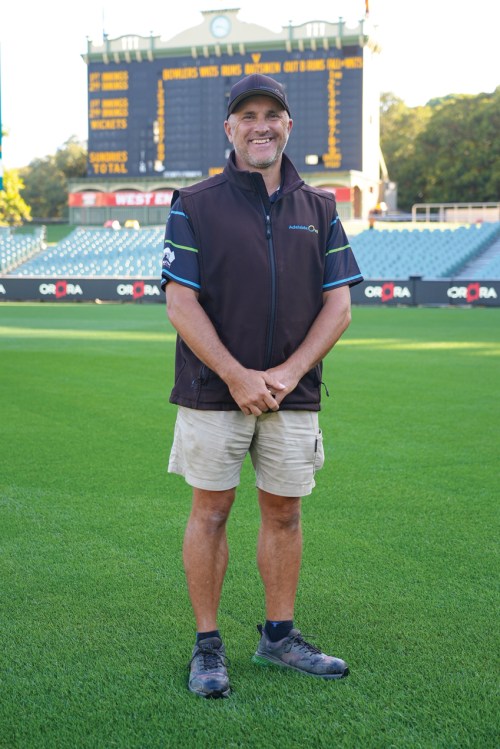
The day before the match, the mower comes out to cut a pattern across the oval and the boundaries are marked.
When “Game Day” arrives, it brings with it a check of soil moisture; if the surface is too dry a quick water may be needed and then during the match, once each quarter finishes, Damian and the team are on divot-replacement and smoothing-duty to maintain player safety. Once the game is over and the crowd is gone, there’s a final walk-and-check before the team packs up and the weekly cycle begins again.
Over and above the already filled sporting calendar, Damian has plenty more turf activities. Post football season, long sand trays hidden under the rye grass in the centre of Adelaide Oval are removed and replaced with drop in cricket pitches. Filled with rare Athelstone clay and covered in Santa Ana couch, these trays are 25m long, 3m wide, 200mm deep and weigh a whopping 30 tonnes. Happily left over winter to grow in the nursery area nearby the No. 2 oval, the swapping and siting of these pitches, at least twice yearly, is an astonishing feat.
Then, added to the calendar could be mega-concerts, like the recent Ed Sheeran concert in March, which left 10,000 square metres of turf needing to be lifted and successfully replaced (in a very short timeframe).
So, the next time you visit Adelaide Oval, give a cheer for this world-class playing surface and the proud people who are keeping it that way.
This article first appeared in the May 2023 issue of SALIFE magazine.



